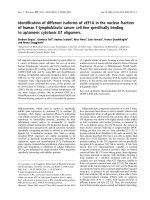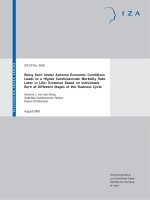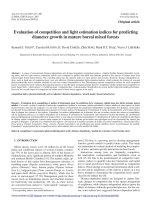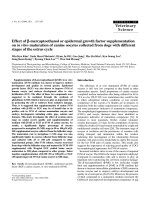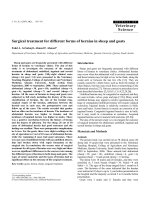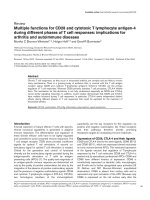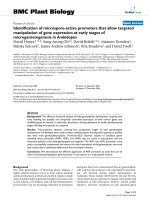Hydrocyanic acid (HCN) estimation during different stages of growth in Gundrijowar (Sorghum vulgare) fodder crop
Bạn đang xem bản rút gọn của tài liệu. Xem và tải ngay bản đầy đủ của tài liệu tại đây (187.43 KB, 6 trang )
Int.J.Curr.Microbiol.App.Sci (2019) 8(9): 1328-1333
International Journal of Current Microbiology and Applied Sciences
ISSN: 2319-7706 Volume 8 Number 09 (2019)
Journal homepage:
Original Research Article
/>
Hydrocyanic Acid (HCN) Estimation during Different Stages of Growth in
Gundrijowar (Sorghum vulgare) Fodder Crop
C. N. Jadav, R. B. Makwana*, S. S. Parikh, P. M. Gamit,
K. S. Murthy and P. U. Gajabhiye
Cattle Breeding Farm, Junagadh Agricultural University, Junagadh- 362001, Gujarat, India
*Corresponding author
ABSTRACT
Keywords
Gundrijowar,
Hydrocyanic acid
(HCN), Sorgum
vulgare, DAS (Day
after Sowing).
Article Info
Accepted:
15 August 2019
Available Online:
10 September 2019
The present research trial was carried out in kharif and summer season from
year 2013-2015 at Cattle Breeding Farm, Junagadh agricultural University,
Junagadh, Gujarat. Gundrijowar fodder samples were collected for
quantitative HCN (mg/100 gm dry matter) concentration from eight sown
plots from 15 DAS (Day after sowing) up to 60 DAS at fortnightly intervals
and one more sampling was carried out when Gundrijowar fodder crops
exhibit 25% flowering stage. Result revealed that concentration of HCN
(mg/100 gm dry matter) in Gundrijowar fodder crop in kharif & summer
season decreased significantly (p<0.05) during the year 2013 and 2015, up
to 25% flowering stage. It was concluded that freshly cut Gundrijowar
(Sorghum vulgare) fodder can be fed safely without any poisonous effect to
animals at 25 % flowering stage.
Introduction
Gundrijowar (Sorghum vulgare) is commonly
grown single cut variety of sorghum in
Saurashtra region of Gujarat. It is nutritious,
palatable fodder crops and it can be fed as
green, dry or as conserved fodder in the form
of silage or hay. Cultivation of sorghum
compare to other forage crops is widely
practiced due to suitability to wide variation in
soil and climatic conditions, its high tolerance
to various stresses and having many
advantages like high biomass accumulation,
quick growth, high dry matter content and
wide
adaptability
besides
drought
withstanding ability (Reddy et al., 2004).
Sorghum is considered to be a good feed in
ordinary conditions but when its normal
growth is constrained by drought or
imbalanced soil nutrients, hydrocyanic acid
(HCN) content may develop to such an extent
1328
Int.J.Curr.Microbiol.App.Sci (2019) 8(9): 1328-1333
that the toxic level may reach lethal level
when fed to animals (Fjell et al., 1991).
Cyanide occurs in the leaves of sorghum as
cyanogenic glycoside dhurrin. Degradation of
dhurrin yields equimolar amount of
hydrocyanic,
glucose
and
Phydroxybenzaldehyde (P-HB).
dry weight basis (Karthika and Kalpana,
2017). Present experiment was planned to
estimate varying levels of HCN in
Gundrijowar (Sorghum vulgare) fodder crop
during their growth period to keep dairy
farmers informed to feeding to ruminant
animals at safe level of HCN.
Ruminant animals are very susceptible to
HCN poisoning because environment of
rumen is slightly acidic, more water content
and microflora present in rumen can rapidly
convert cyanogenic glyocosides available in
plants to free cyanide gas “Prussic acid
poisoning or hydrocyanic acid poisoning
(HCN)”. Due to ignorance and lack of
knowledge, dairy farmers feed freshly cut
sorghum from early stages of growth, when
cyanide is taken to the body, it’s rapidly
absorbed and circulated, then it’s merged with
methemoglobin
and
forms
cyanomethemoglobin. The circulating cyanide
inactivates cytochrome oxidase enzyme by
binding ferric (Fe+++) iron which is within
this enzyme. Normally the cytochrome
oxidase enzyme catalyzes the last step of
oxidative phosphorylation.
Materials and Methods
The enzyme-cyanide complex prevents this
task from being performed. Because of that
the enzyme can’t combine with oxygen and
electron transportation becomes inhibited. The
patient can’t use caloric oxygen and cellular
respiration stops immediately. As a result of
this process, death occurs due to histotoxic
anoxia. The death of animals and even at
doses as little as 0.5 gm is sufficient to kill a
cow. The risk of HCN toxicity decreases with
maturity of the plant, older plants and leaves
contain less cyanogenic glycoside (Carlson
and Anderson, 2013). Srinivasa et al., (2006)
recorded that high HCN content in the
sorghum plant in early growth stage, which
decreased with plant maturity. The safe limit
of HCN in green forage for livestock is 500
ppm on fresh weight basis and 200 ppm on
Experimental Design
The present research trial was conducted in
randomly selected 8 plots (100x100 sq meter
sizes) in which Gundrijowar (Sorgum vulgare)
fodder crops were cultivated in kharif and
summer season from year 2013-2015.
Agro climatic region & Place of work
The present research trial was conducted at
Cattle Breeding Farm, Junagadh agricultural
University, Junagadh, under south Saurashtra
agro climatic region, Gujarat, India.
Sampling materials
Soil samples were collected before starting of
trial followed by standard procedure from total
8 selected plots under trail for estimation of
Nitrogen, Phosphorus and Potash.
In Cattle Breeding Farm, Junagadh
agricultural University, Junagadh, Gujarat,
Gundrijowar is sown in summer and kharif
seasons.
Hence, samplings were limited only in two
seasons. Gundrijowar fodder samples were
collected for quantitative HCN (mg/100gm
dry matter) concentration from eight sown
plots from 15 DAS (Day after sowing) up to
60 DAS at regularly fortnightly intervals and
one more sampling was carried out when
Gundrijowar fodder crops exhibit 25%
flowering stage.
1329
Int.J.Curr.Microbiol.App.Sci (2019) 8(9): 1328-1333
Quantitative estimation of HCN (mg/100
gm dry
matter)
concentration
in
Gundrijowar (Sorgum vulgare)
HCN
(mg/100
gm
dry
matter)
concentration in Gundrijowar (Sorghum
vulgare)
Quantitative estimation of HCN (mg/100 gm
dry matter) was done according to AOAC
(1995) as under:
Concentration of Hydrocyanic acid (HCNmg/100 gm dry matter) measured at
fortnightly intervals from 15 DAS (Day after
sowing) up to 60 DAS from Gundrijowar
fodder samples from eight sown plots and one
more sampling was carried out when
Gundrijowar fodder crops exhibit 25%
flowering stage.
Two gram of green chopped Sorghum sample
was taken in a test tube and moistened with
distilled water. Few drops of chloroform were
added to the contents of the test tube. Sodium
Picrate filter paper strips (1x10 cm Whatsman
filter paper no.1) were prepared by dipping the
strips into solution containing 1% Picric acid
and 10% Sodium Carbonate and air dried.
Filter papers were inserted into the test tube
containing fodder sample and closed with a
rubber cork.
Change in color of filter paper happened
immediately after five minutes, however strips
were allowed to remain for about six hours in
the test tube. Filter paper turned from yellow
color to brick red color as per the
concentration of HCN. After evaluating
qualitatively, filter paper strips were removed
from the test tube chopped to small pieces in
to another test tube containing 10 ml distilled
water.
Filter paper strips were thoroughly mixed in a
Cyclomixer and centrifuged at 5000 rpm for
10 minutes and color intensity was read using
Spectronic 20 @ 520 nm. Standard curve was
prepared by following the above method using
Potassium Cyanide.
Observations Recorded
Soil analysis for Nitrogen, Phosphorus and
Potash
Soil testing was carried out for total 8 selected
plots for Nitrogen, Phosphorus and Potash
before starting of trial (Table 1).
Statistical Analysis
All the recorded data were subjected to
statistical analysis by “factorial and
completely randomized design” (FCRD)
employing one-way analysis of variance as per
Snedecor and Cochran (1994).
A p-value of <0.05 was considered as
significant difference among the treatments
groups and the comparison of means were
tested as per Duncan’s multiple range test
(DMRT) described by Duncan (1955).
Results and Discussion
Concentration of HCN (mg/100 gm dry
matter) in Gundrijowar fodder crop was
decreased significantly (p<0.05) up to 25%
flowering stage in summer season during the
year 2013 and 2015. While in the year 2014
significant decline was up to 60 DAS and the
concentration was at par at 60 DAS and 25%
of flowering stage. Pooled data showed
similar trend to that of the year 2014 with
reference to HCN concentration (Table 2).
Concentration of HCN (mg/100 gm dry
matter) in Gundrijowar (Sorghum vulgare)
fodder crop was declined significantly
(p<0.05) up to 25% flowering stage in kharif
season during 2013 and 2014, respectively. In
kharif season of the year 2015, HCN
concentration though declined from 15 DAS
1330
Int.J.Curr.Microbiol.App.Sci (2019) 8(9): 1328-1333
to 45 DAS significantly and it was at par at 60
DAS and 25% flowering. In the pooled data,
HCN concentration decline was similar to that
of the year 2015 (Table 3).
Table.1 Nitrogen, Phosphorus and Potash concentrations of
Soil (8 plots) selected for thestudy.
Sr.
No.
Plot No.
(1:2.5)
EC ds /m pH
0.28
8.15
1.
11/3
2.
11/4
0.25
8.2
3.
12/2
0.37
7.97
4.
12/3
0.51
7.93
5.
12/4
0.31
7.96
6.
14/1
0.27
8.45
7.
14/2
0.36
8.43
8.
14/3,4
0.33
8.18
O.C.%
Nitrogen
kg/ha
Phosphorus
(P2O5) kg/ha
Potash
(K2O) kg/ha
1.02
High
0.81
High
0.99
High
0.93
High
0.99
High
0.90
High
0.99
High
0.90
High
355.0
High
389.0
High
317.0
High
279.0
Medium
622.0
High
299.0
Medium
302.0
High
540.0
High
39.49
Medium
35.39
Medium
50.27
Medium
44.62
Medium
67.19
High
40.01
Medium
28.21
Medium
37.44
Medium
110.0
Low
99.0
Low
320.0
High
192.0
Medium
386.0
High
82.0
Low
148.0
Low
121.0
Low
* From soil composition it is evident that Nitrogen, Phosphorus and Potash concentrations were usual in comparison
to other plots in CBF.
Table.2 Concentration of HCN (mg/100 gm dry matter) in Gundrijowar (Sorghum vulgare)
fodder crop at different stages after sowing during summer season from 2013-2015.
Treatment
15 DAS
30 DAS
45 DAS
60 DAS
25% Flowering
S.Em.±
C.D. at 5 %
C.V. %
Year
S.Em.±
C.D. at 5 %
YXT
S.Em.±
C.D. at 5 %
Summer-2013
376.13
291.25
137.00
33.00
10.25
7.15
20.54
11.93
Summer-2014
297.13
171.25
92.00
35.88
13.50
12.93
37.16
30
Summer-2015
273.50
180.25
98.00
53.25
18.63
9.76
28.03
22.13
Pooled
315.58
214.25
109.00
40.71
14.13
19.42
63.33
20.85
15.04
49.05
10.22
28.70
1331
Int.J.Curr.Microbiol.App.Sci (2019) 8(9): 1328-1333
Table. 3 Concentration of HCN (mg/ 100 gm dry matter) in Gundrijowar (Sorghum
vulgare) fodder crop at different stages after sowing during Kharif season from 2013 to 2015.
Treatment
15 DAS
30 DAS
45 DAS
60 DAS
25% Flowering
S.Em.±
C.D. at 5 %
C.V. %
Year
S.Em.±
C.D. at 5 %
YXT
S.Em.±
C.D. at 5 %
Kharif-2013
275.88
151.88
75.38
39.13
18.38
9.95
28.58
25.09
Kharif-2014
306.88
181.75
109.75
42.63
14.38
7.55
21.69
16.29
Kharif-2015
218.13
107.13
56.63
32.63
17.75
8.15
23.42
26.67
Pooled
266.96
146.92
80.58
38.13
16.83
11.86
38.67
22.16
9.19
29.96
8.61
24.17
Muthuswamy et al., (1976) reported that HCN
content was more at the early stage of crop
and it decreased at maturity stage. They found
that the HCN content was high 18 days after
sowing and decreased gradually up to 53 days
in CSH 5 type of hybrid variety of sorghum.
Chaturvedi et al., (1994) reported that HCN
content decreased significantly from 65 days
after sowing to gain maturity stage. Wheeler et
al., (1990) also reported decrease in HCN
content with plant age in sorghum.
It could be concluded that irrespective of the
initial HCN concentration (mg/100gm dry
matter) in Gundrijowar (Sorghum vulgare) at
15 DAS, it declined to safe level of feeding to
ruminant animals at 25 % flowering stage.
Acknowledgments
Authors thank the University authorities,
Research scientist and Head, Cattle Breeding
farm, Professor & Head, Department of
Agriculture Chemistry & Soil Science,
Junagadh agricultural University, Junagadh,
Gujarat for facilities provided and cooperation
extended for this work.
References
AOAC. (1995). Official Methods of Analysis.
16th Edn., Association of Official
Analytical Chemists, Washington,
DC., USA.
Carlson, M.P and Anderson, B. (2013).
Cyanide poisoning.
Chaturvedi, V.K., Devender, V and
Kandalikar, S.S. (1994). Hydrocyanic
acid content in released hybrids,
varieties and parental line of grain
sorghum (Sorghum bicolor) at two
growth stages. Indian Agric. Sci.,
64(4): 403-404.
Duncan, D.B. (1955). Multiple Ranges and
Multiple F Test.Biometrics, 1: 1-42.
Fjell, D., Dale, B and Gene, T. (1991). Nitrate
and prussic acid toxicity in forage
causes, prevention and feeding
management, Cooperative extension
service, Kansas state university,
Manhattan, Kansas, USA, pp. 1‒4.
Karthika, N and Kalpana, R. (2017). HCN
Content and Forage Yield of Multi-Cut
Forage Sorghum under Different
Organic Manures and Nitrogen Levels.
1332
Int.J.Curr.Microbiol.App.Sci (2019) 8(9): 1328-1333
Chemical Science Review and Letters,
6(23): 1659-1663.
Muthuswamy, P.M., Govindaswamy and
Krishnamurthy, K.K. (1976). Effect of
stage of cutting on the crude protein
and prussic acid content of CSH 5
sorghum. Madras Agron. J., 63(3):
200-204.
Reddy, B.V.S., Ramesh, S and Reddy, P.S.
(2004). Sorghum breeding research at
ICRISAT- goals, strategies, methods
and accomplishments. International
Sorghum and Millets Newsletter, 45: 512.
Srinivasa, D.H., Dwivedi, R.R., Govindan, R
and Joshi, A. (2006). Status of
hydrocyanic acid content of sorghum
in relation to anthracnose caused by
Collectotrichum graminicola (Ces)
Wilson. Environment and Ecology,
24(3): 680-683
Snedecor, G.W and Cochran, W.G. (1994).
Statistical Methods, 8th edn. Affiliated
East-West press Pvt. Ltd., New Delhi,
India.
Wheeler, J. L., Mulcahy, J.L., Walcott, J and
Rapp, G. (1990). Factors affecting the
hydrogen cyanide potential of sweet
Sorghum. Australian Journal of
Agricultural research. 41: 1093-1100.
How to cite this article:
Jadav, C. N., R. B. Makwana, S. S. Parikh, P. M. Gamit, K. S. Murthy and Gajabhiye, P. U.
2019. Hydrocyanic Acid (HCN) Estimation during Different Stages of Growth in Gundrijowar
(Sorghum vulgare) Fodder Crop.. Int.J.Curr.Microbiol.App.Sci. 8(09): 1328-1333.
doi: />
1333
